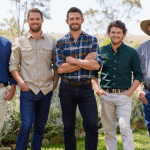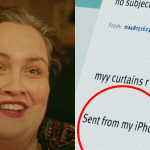
The mustachioed dude above is Joseph Allen Shea, custodian of independent publishing house Izrock, curator for Sydney’s Monster Children Gallery and sometime writer, photographer and freelance aesthete. We spoke to Joseph a few months ago but considering the impending staple-mania of this weekend’s MCA Zine Fair we thought we’d post this zine-centric interview today. Read on as Shea discusses the camaraderie of Australian independent publishers, the recipe for a good magazine and a truly touching (but non-cheesy) story about his most beloved zine.
So Joseph, tell us what are you working on and what you’ve been doing in say the last year or so? Okay. Currently working on..Well the next book project is another book by French, the British artist French. So I’ve done two zines with him already, a zine and a newspaper print. We’re going to do a full book. We’re going to make it a thick, chunky, kind of almost bible-esque book with some nice hard cover and hopefully gold edging so it really gives it that, I don’t know, bible-like quality. We’re doing that.
Yeah, cool. It seems like art that is born from subculture is the art of our generation. Was that the same entry point for you growing up? Definitely. I think that’s really what I’m interested in, really what I’m focusing on. I mean I do look at institutionalized art, people who came up through art school and art showing in museums. I am interested in that but I get a lot more excitement out of things that have come from somewhere else or through the back door so to speak. I mean they are the cultures I’m interested in, even if I wasn’t looking at the art because I grew up skateboarding or I grew up surfing. I mean, I didn’t really do too much graffiti but music and those things, that’s what gives me energy. So art revolving around those cultures that’s what I’m interested in.
So, how did Izrock start? Because now it seems that publishing is probably one of the least financially viable industries – what prompted you to do it? My background is graphic design, that’s what I studied. At some stage I stopped working for businesses. I don’t know how long I worked for businesses but I was freelancing and I needed a name and came up with that in a round about way. I came up with Izrock mixed business so it was the idea that I was doing a bunch of different things and I could put everything under one banner. Mixed business also being the subtitle for convenience stores that you see, the kind that suggests they do a lot but never really tell you exactly what they do. So I kind of feel like that.
Dry cleaners out the back… Pretty much. Yeah, yeah, plus soy milk and drugs under the counter and…So I was doing a whole bunch of things and I tied it into doing graphic design, curation and printing zines. I didn’t really take the publishing side too seriously at that stage. I guess this was five years ago when I started using that name. I was just making zines and putting it all in there and then going from there, building up all these different things. With the graphic design I was doing I wanted to focus more on art and so eventually I did.
And how has it been going? You mentioned before that you didn’t really take the publishing side too seriously but now that’s what Izrock is synonymous with. What’s changed in those five years? I think just focus. I mean I’ve always loved books and especially artists books, monographs, small run publications and I guess I was making art at some stage. I still do but I guess somewhere along the track I realized that I wasn’t going to be a career artist. That drive wasn’t as deep as I saw in other people and I wasn’t going to go down that path but I was hanging out with all those artists and I was involved in that scene and I wanted to contribute in some way and I had my graphic design skills. I just thought this is how I want to work inside the art world, whatever you want to call it.
 Fashematical by Fashematics (Jonathan Zawada)
Fashematical by Fashematics (Jonathan Zawada)
I completely understand that. Like for me I’m such an avid lover of pop culture except I don’t have enough drive or talent to be involved in that world directly but through journalism or media or whatever, I can be involved indirectly in that world. Which is a totally valid skill to have and needs to be in that culture. I mean I’m the same. I like talking about other people’s work, I love presenting work, I love showing things, I’m a fan, I really love it. A lot of those artists, they can’t do that for themselves and similarly with you, an artist can’t go and write an article on themselves and publish it in a magazine so it’s a sharing of operations, and both very needed.
What do you actually provide as a service as far as the publishing side goes? I guess I approach an artist or we come together with an idea. I do all the layout and graphic design. Well less so with someone like Jonathan Zawada because he’s an accomplished graphic designer. For example the Fashionmatics zine, I really didn’t have to do too much work and everyone loved it so I didn’t have to do the hard sell. But, yeah, I would usually layout the books, put the money up, liaise with the printer and I do all my own sales and sale distribution at this point. So I’m like chasing up shops, walk in there, hand delivering books, going to the post office every day, all the back end as well.
Is it a democratic process as far as laying out or do they trust you with full control? I’ve been trusted to tell you the truth like I’m totally open to suggestions but the thing is, I want these books to be a representation of the artists and not me and that’s what you see in the graphic design. There is pretty much no graphic design. It’s just image, image, image. So I don’t want to be inside that book. I want it to be all about the artist, but I haven’t had to fire anyone. I’m always like back and forth with the artists, what do you think of this? What do you think of that? I make sure that it represents them to a certain degree. I mean it can be too close to them as well, I can be away from it and say well, look this is a great cover image. That one, I know you probably have emotional ties to it but this will probably work better.
And how about actually producing the zines, that might get pretty tiresome… No, not really. Not for these projects. Everything has gone pretty smoothly. I mean the worst or the most tiresome aspect is the amount of time that goes into making a hand stapled, hand made zine. I mean when you give it to a printer, it is like yeah, deal with it. But you know, I’ve been up all night stapling and stuff and that can actually be really fun especially if you are with pals and you are doing something collaborative. I mean there used to be a little crew of us that always went to zine fairs for years. It was myself, Dave Ladd of He She It They I, Mark Drew of Making Ends and China Heights and Tristan Ceddia of Serps and we would be a team so we would make zines together. If there was a fair coming up, we would be there the night before, like stapling all through the night. It was fun, good times. You know, dudes just sitting around and talking shit.
That kind of leads into my next questions because it seems like there’s a lot of independent publishers popping up in Sydney and Melbourne. Why do you think that is? Yeah. I mean I think everything feels connected. I think people realize. I mean, I hate to put things down to trends because I think it is deeper than that but art is very in right now which is great. As well as that we’ve all become so accustomed to the internet and the internet is great but it’s not the greatest way for viewing images and it’s not so great for reading long text and there’s something physical that’s really missing on the internet.
 Project Rooms, Mark Whalen (Kill Pixie)
Project Rooms, Mark Whalen (Kill Pixie)
The tangibility, collectivity, all that kind of stuff… Yeah, it is. I mean you can own it. It’s yours. Yeah, it’s collecting, it’s sharing…
Even the process of finding a zine, like with the internet it’s so easy to access information but you kind of have to leave your house and go on the hunt to find a zine… Yeah, I mean that’s collecting and being savvy or being involved or being nose to the ground and sniffing something out, finding it. That doesn’t really exist on the internet, it’s always there, anyone can get to it. But yeah, it’s physical, it’s yours, you can bend the ear of the paper and it becomes yours, you can hold it, you can spend way more time with something physical and tangible than you can with something on the internet. I think that’s a bit of a cottage industry as well.
It is isn’t it? It’s a bit personal and it is a bit – I don’t know – I think you can feel like you are involved in something a lot more.
Yeah, so do you guys still keep tabs on each other? I think so. We’re all friends. We know each other. I mean we all kind of came out independently. I started printing before I met – no actually, I met Tom Jeppe at Serps Press just before I started printing, he had already printed his book Home Made Tattoos Rule so we could talk about that. I met Tristan just after. Dave Ladd, He She, I always forget that. He She It They I, I used to live with him in London although he’s Australian, we met there. Jeff Burch I met later. I really love what he’s doing. And then the Rainoff guys, like Doug was an assistant of mine. I’ve known him for a couple of years. Sinisa was too, and Robbie just worked around the corner, so we were like…
It’s all pretty incestuous, isn’t it? Yeah, it is. That makes it sound dirty. It’s great. But yeah, we all know each other and we’re all doing our thing. We help each other out with printing suggestions or contacts for different book stores and we all share, that’s the really beautiful thing as well, like you make something new and you give it to your friend and then when they make something new, they give it back. It’s really nice.
So, where do you see the future of that kind of niche publishing? I think it will exist for a long time. I think it will go through cycles, get big and small but I think there will always be books.
And purists who love them. Yeah. And purists will buy them and look at them and own them and want them, and collect them. I think they will always be there but of course the internet killed a bunch of stuff. But then, at the same time, it has also built this renaissance as well by killing it and then making it necessary through its own faults.
What was the first zine you ever bought? I don’t know. Been around for a long time. I mean we used to make like stupid school skate magazines which we’d hand copy when I was fifteen, fourteen.
Xeroxes. Yeah, totally which is a great look. I have a real nostalgia for that look. It’s raw, it’s real, it’s part of our culture even if it’s kind of ugly, it’s really beautiful. It’s like the cheapest, shittiest reproduction ever but it really has a charm and that nostalgia.
And what, to you, constitutes a good zine? Something that someone really believes in I guess. Something personal, something authentic, something that someone’s really like done it, put their heart into it, I don’t really care how it’s printed, bound, stapled, what colors but the content just has to be – yeah, you can tell when someone’s believed in it. They really want it to happen and they worked through the night. And I also really like quick zines. You can tell it’s got an energy, this kind of burst of energy and they’ve done it all in a day. It can be of the moment and when you feel that, it’s really beautiful. I mean, I even think the zines that I have made in a day have been way more exciting than or can be way more exciting than a book that’s taken half a year to make.

Margaret Kilgallen Installation at UCLA / Armand Hammer Museum, Los Angeles, 2000.
And finally, personally, what’s your favorite zine? My favorite zine is not even mine although I do have it in my bookshelf. My friend Brent from Byron Bay lent me – he used to live in New York and he’s got this Margaret Kilgallen zine and he’s like I know you will really like this. You can just borrow it on extended loan and show your peers or whatever but it is beautiful. Obviously the artist has passed. I mean it’s a real – because it is handmade you know she was there, the artist was involved in it and now she’s gone. It’s like this time capsule and I don’t want to say anything too spiritual but she’s still there, like her hand lives on and l’ve got a copy and however many other people have a copy as well. It’s like a legacy thing. Really, it’s not like I’m looking at her art work in a reprint. She printed it and stapled it. That’s pretty fantastic.
Wow dude I don’t know what to say. The fact that you’ve got a Margaret Kilgallen zine sitting on your bookshelf is just so…important? I don’t know if that’s the right word… I know what you mean, it’s so necessary. Like the DNA of someone living through paper and ink. That’s why I love it.
All Images Provided by Joseph Allen Shea



